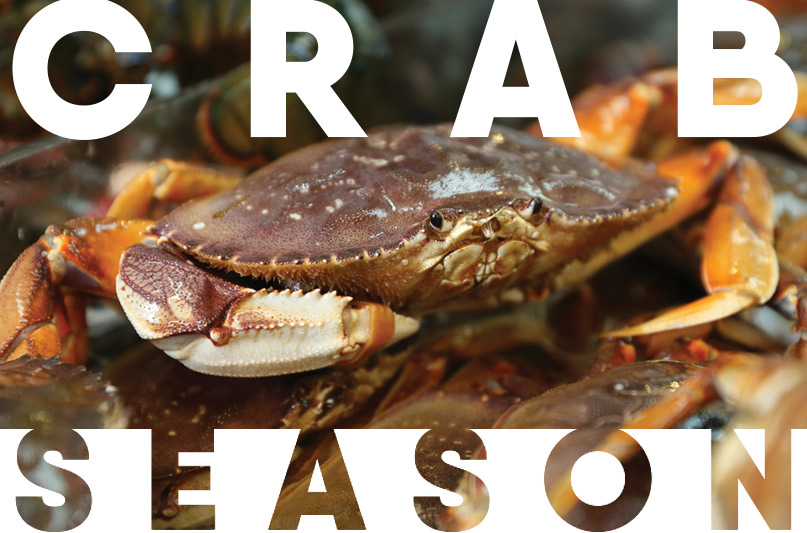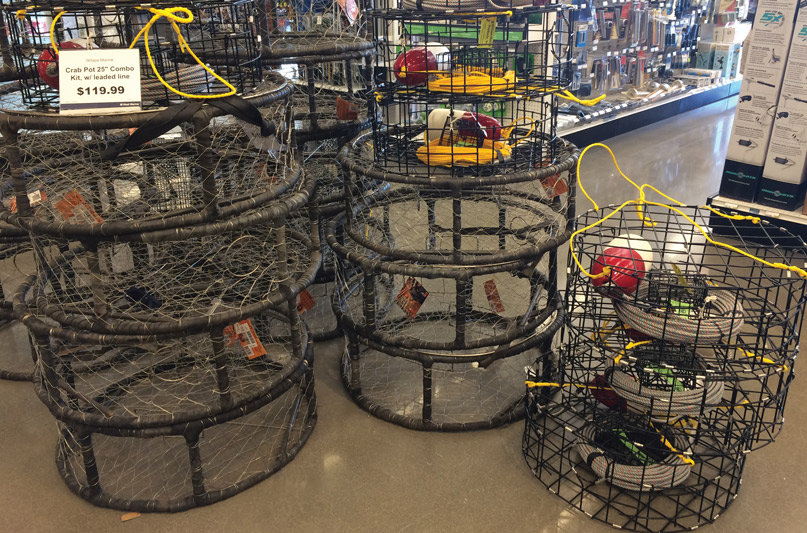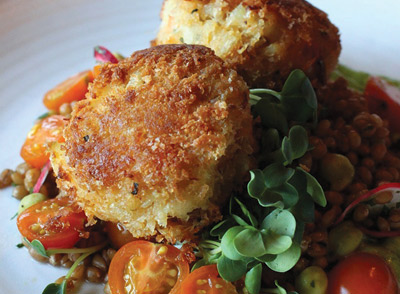
 Nothing says spring in the Northwest more than appreciating the local seafood we have available here. Dungeness crabs have always been an absolute favorite of mine amongst the varied local fare, and it’s the thing I look forward to most when I order from a coastal restaurant or café. Crab cocktails – served cold, with the smallest dab of cocktail sauce, if any at all – is a standout, as well as crab meat straight from the legs and crab eggs benedict. Any recipe where the meat can shine on its own and be the star of the plate is the best!
Nothing says spring in the Northwest more than appreciating the local seafood we have available here. Dungeness crabs have always been an absolute favorite of mine amongst the varied local fare, and it’s the thing I look forward to most when I order from a coastal restaurant or café. Crab cocktails – served cold, with the smallest dab of cocktail sauce, if any at all – is a standout, as well as crab meat straight from the legs and crab eggs benedict. Any recipe where the meat can shine on its own and be the star of the plate is the best!
A day crabbing can be even more relaxed than a day spent fishing, given that you’ll usually have to let your pots soak for a little while. You could spend that soak time either doing some other kind of fishing, or just relaxing, soaking up the Pacific Northwest sunshine, talking with your friends who have come out with you, and generally just enjoying the day. And even if the sun isn’t out, a day out on the water, or by the water, is never completely wasted.
Unfortunately, my crabbing outings in the Pacific Northwest have been mostly unsuccessful. While living in Astoria on the Columbia River, a few friends and I attempted to catch some crab in the brackish water of one of the nearby creeks, though we came up empty-handed.
On a charter fishing trip with some friends in Newport, we passed on getting a crab license for the day, and then watched jealously as people took delicious fresh Dungeness home with them (and kicked ourselves for being too miserly).
Up here in Alaska where I now live, the king of crabs is just that – the Alaskan king crab. But, being an Oregonian at heart, I have a soft spot (though not soft shelled) for Dungeness crab. Dungies can still be caught up here, but Puget Sound is a particularly great spot for finding these orange and purple crustaceans.
There are many different species of crabs in the Pacific Northwest, though there are a handful that are more common and more likely to be seen during a walk on the beach or pulling up a pot. Most of these species aren’t large enough to fish, but two notables are.
Dungeness Crab
Dungeness crab (or “Dungies”) named after the coastal town of Dungeness, Washington, are probably the most widely known and recognizable species of crab in the Northwest. This is due to its popularity as a commercially and recreationally caught species. They grow up to about almost 8” and have meat often thought of as being very sweet and tender.

Like all species of crab, Dungeness crabs go through a process called molting, or ecdysis, which is like a snake shedding its skin. During this period the crab is very delicate and vulnerable, which is the main reason there are crabbing closures during certain times of the year. Washington Department of Fish and Wildlife (WDFW) requires that all soft-shell crab be returned to the water. This is in your interest as well—soft-shell crab meat is known for being mushy and flavorless.
Puget Sound King Crab
You’ve heard of Alaskan king crab, but did you know there is also the Puget Sound king crab? While similar to the Alaskan species in size and overall appearance, the main difference is the length of the legs – there’s a reason people eat Alaskan king crab and not Puget Sound king crab! This species, along with the box crab, can fold their legs against their body so that they, in fact, resemble a compact box.
Recreational crabbing is common practice in the Pacific Northwest, partially due to the relatively low cost and complexity of the hobby. However, knowing a thing or two about gear and technique goes a long way toward hauling in full pots in the first go.
Gear Insight
Having the right gear is essential for any good day out on the water. If you are headed out on your own, you will need to make sure you have all the right gear with you, and you are responsible for any legal requirements (license, catch records card, specs on gear, etc.). If you are going out on a charter vessel, the charter will make sure that all the correct boxes are checked off before you head out.
Your essential gear for crabbing, in addition to your licenses, endorsements, and cards, is what you use to actually catch the crab. Crab pots are the most common method for catching crab. Pots are constructed using an iron frame and wrapping netting or wire mesh around it, with two funnel-shaped openings where the crab would enter.
To prevent the crab from doing a rapid exit, there are trigger devices in the tunnel. If the pot has the trigger device, it is required to have a 4¼” inside diameter escape ring. This allows for smaller crab (particularly undersized crab) to escape. Also, to prevent ghostfishing (left-behind crab pots that continue to catch crab), the pot is required to have a biodegradable escapement device, usually a part that will biodegrade and eventually allow animals to escape if the pot is not retrieved.
Tips & Technique
Depending on where you plan to go fishing, lightweight pots might be suitable. If there are strong currents in your area, however, a lightweight pot may get carried away in a current. You can weigh down the pots with rocks, though as with most things in fishing, it’s a trade-off – because weights in the pot take away potential space for more crab.

Make sure to allow for enough line, for you need to balance the amount of line out with how deep the water is, how strong the currents are, and how not to cause a hazard for other boaters. You also need to account for tidal changes – if the tide comes in and you didn’t give enough line, your buoy may be submerged.
The other risk is that if you used a lightweight pot, or you over compensated on the number of floats, your pot could float or bounce on the bottom and be carried away with current. However, don’t give out so much line that you are putting other recreational boaters at risk of getting a line tangled in their prop!
Seattle-based celebrity chef Tom Douglas chimes in with crab cake advice. Often described as the chef who put Seattle on the culinary map, Tom has earned national recognition, including the James Beard Award for Outstanding Restaurateur in 2012.
Crabmeat:
The most important thing is to use crabmeat that’s best and freshest in your area. Here in Seattle, we make our crab cakes from Dungeness, using the body, leg, and claw meat.
Draining and Squeezing Crabmeat:
Dungeness tends to be wet. Before you make crab cakes, drain the crabmeat in a sieve. Gently squeeze the crabmeat with your hands to remove excess liquid and at the same time feel for any bits of cartilage or shell and remove them. Don’t go overboard squeezing your crabmeat because you don’t want to squeeze out all the flavor or make it too dry.
Mixing and Handling:
Mix gently. Crabmeat is graded and priced on the size of the lumps. It’s a treat to find some nice, intact lumps of crab meat inside your crab cake, and you don’t want to smash them up by overmixing. Fold the crabmeat and the dressing together with a rubber spatula as if you’re folding whipped cream into a mousse.
Salting:
Some Dungeness is very salty. Taste your crabmeat first and adjust the salt in the recipe accordingly.
Chilling Crab Cakes:
Once shaped, most crab cakes will be easier to handle if you chill them before cooking. You can put them in the refrigerator, leaving them right in the pan of crumbs and covered with plastic wrap for at least 30 minutes, or for several hours, or even overnight. Another idea is to refrigerate the crab mixture first, then scoop and crumb the cakes right before you cook them.
Forming Crab Cakes:
A two-ounce ice cream scoop with a release lever is the perfect tool for shaping a classic 2½- to 3-ounce cake. Lightly pack the scoop with the heel of your hand and release the cake directly into the pan of bread crumbs. Press the crumbs around the cake while you’re shaping it into a disc.
Cooking Crab Cakes:
The easiest way to tell if a crab cake is cooked and hot all the way through is with an instant-read thermometer. Insert the thermometer into the center of the cake and if the temperature reads 145°F, you know your crab cake is fully cooked. Turn the crab cakes only once while cooking. Flip flopping them is likely to break them apart and you won’t get a nice crust. When you cook the crab cakes, use a good, seasoned cast-iron pan, or a shiny stainless steel sauté pan such as an All-Clad or a KitchenAid, or a pan with a nonstick surface.
TOM DOUGLAS’ DUNGENESS CRAB CAKES:
Adapted from I Love Crab Cakes by Tom Douglas (Morrow, 2006).
Makes 8 crab cakes (serves 4 to 8 depending on whether you serve 1 crab cake or 2)
- 1 pound Dungeness crabmeat, drained, picked clean of shell, and excess moisture lightly squeezed out if your crabmeat is very wet
- ½ cup plus 2 tablespoons mayonnaise; preferably Hellman’s or Best Foods
- 2 tablespoons and 2 teaspoons grated lemon zest
- ½ teaspoon kosher salt
- ¼ cup minced scallions, white and green parts
- ¼ teaspoon freshly ground black pepper
- ½ cup panko bread crumbs, plus 2 cups more for dredging (see note)
- 5 tablespoons unsalted butter
- Green cocktail sauce (see recipe)
- Lemon wedges
To make the crab cakes, put the crabmeat, mayonnaise, lemon zest, scallions, salt, and pepper in a large bowl. Mix everything together gently with a rubber spatula. Add the ½ cup of panko and mix again. Pour the remaining two cups of panko into a shallow container. Form the crab mixture into eight patties. Pat them gently into shape without pressing them too much.
Drop the patties into the panko and turn them to coat both sides, patting to shake off the excess. If you have time, you can let the crab cakes chill in the refrigerator an hour or more before frying. When you are ready to fry the crab cakes, preheat the oven to 450°F. Put two large non-stick skillets over medium-high heat and add about two and a half tablespoons of butter to each pan. As soon as the butter is melted, add four crab cakes to each pan.
Leave the pans on the burners for a minute or slightly less (the butter should not be starting to brown), then place the pans in the oven. Cook the crab cakes until they are heated through and golden brown on both sides, about 12 minutes, carefully turning them with a spatula about halfway through the cooking time. Remove the pans from the oven and transfer the crab cakes to plates. Serve with the green cocktail sauce and lemon wedges.
Note: Panko or Japanese bread crumbs are coarser than ordinary bread crumbs and stay nice and crisp when fried. Panko can be found in Japanese fish markets and in many large supermarkets.
To make Tom’s Green Cocktail sauce, keep reading on issuu.

To prevent this, you need to weigh down the lines with a small weight, just enough to keep the line submerged. The general advice I have received from fisherman is to look at the depth marked on your chart for the area that you are fishing, and double that for the length of line.
There are other less common methods of crabbing, including ring nets, long-handled dip nets from boats, short-handled dip nets while wading, and hook and line.
Ring nets are like a collapsible basket, which a crabber lowers to the seafloor with some bait inside. The crabber allows time for crabs to come to the bait, and then quickly hauls up the net to trap the crab inside the basket. Dip nets from boats or beaches are used by running a dip net (a large net with a metal rod as a handle) along the bottom of shallow areas and scooping up the crab.
Hook and line isn’t very common but is executed by making a bird’s nest out of monofilament line with the intention that a crab will get tangled and be caught. I have also come across the method of using snares, which are loops that tighten around a crab’s leg as it tries to get away. I’ll confess, I’m not entirely familiar with the Washington state regulations on these alternative crabbing methods. You’d best check in with WDFW.
To fish for crab in the Puget Sound you need to have a Washington state fishing license if you are 15 years or older. This can either be in the form of an annual shellfish and seaweed license, which would only allow you to harvest these organisms, or you can get a combination fishing license to also fish for other species during the year.
In addition to a license, you need to have a crab endorsement and carry a catch records card. This card accounts for all Dungeness crab that are caught. At the end of the summer or winter (depending on when you get your card), there is a deadline for turning it in, and you will receive an annoying $10 fine if you miss the deadline. They can be returned online or can be dropped or mailed to the WDFW.
To a fisherman or recreational crabber, these cards can seem like a bit of a pain, but they provide valuable data about the state of Dungeness crab populations in Puget Sound. These cards are used to estimate the recreational harvest for the upcoming year. By submitting your data, you are helping ensure decisions made by fisheries managers are as accurate as possible.
Being as accurate as possible also includes submitting cards when you caught zero crab! It may be painful to admit you got skunked, but fisheries managers are equally concerned, if
not more so, by instances when someone has tried to go out crabbing or fishing and didn’t catch anything. As I’ve had it hammered in to me many times as a fisheries science graduate student—zero is not the same as no data; zero is a number!
By having accurate data, this prevents two situations from potentially happening: overharvesting of Dungeness crabs, resulting in a damaged stock for future recreational or commercial fishing; or, unnecessary conservative restrictions and limits of fishing, which wouldn’t allow for people to take full advantage of a public resource. Fisheries managers are constantly attempting to strike that balance, and the best way to do so is to have accurate data – so, please submit your cards!
In addition to the above requirements, remember the three S’s: Size, Sex, and Season. You may only retain crab that are 6¾” or larger. The cards will usually say how many crab may be kept per day, and only males are kept, because it is more essential that more female survive to maintain a stable stock. Many of the marine areas on the Pacific coast of Washington State are open to crabbing every day, year-round. If a marine area is currently closed to crab fishing (usually areas within Puget Sound), they will be open during the summer of this year (2018), but make sure to check before heading out. Closures are usually due to it being a peak soft-shell period for Dungeness crab, meaning that they are going through a molting season and are very vulnerable, don’t have a good meat-to-body weight, and at the very least, don’t taste very good. You are required by WDFW to return soft-shell crab to the water.
Pots keep crab in great condition – a crab returned to the water after being caught in a pot generally has a high chance of surviving, in comparison to a fish that has been fighting and stressing itself out on a line for a long time. If you do find crab that cannot be kept (are either females or are too small), drop them as gently as possible to prevent their shells from cracking, and definitely don’t do the “frisbee toss.”
Return them to the water as soon as possible—crab sitting out of the water for any period of time will start to dry out (or desiccate), lowering their chance of survival due to increased fragility of their shell. A study conducted by Dr. Noelle Yochum of the Alaska Fisheries Science Center showed that increased times out of water and dropping crab from large heights above the water (say from a boat or a pier) can crack the shell of a Dungeness crab, and severely decrease their chance of surviving. If you are high off the water, lower the crab gently to the water with a bucket so it has the best chance to recover.
In conclusion, if you are planning on going fishing out on a charter vessel, many will have the option to add crab on to your license for the day, and I would highly recommend it! You’ll be jealous of your fellow shipmates that get to take home some delicious, fresh Dungeness crab at the end of the day.


